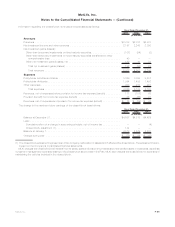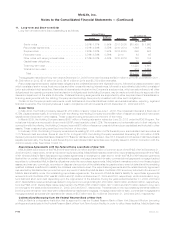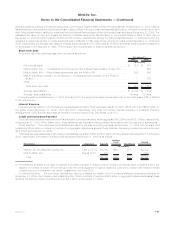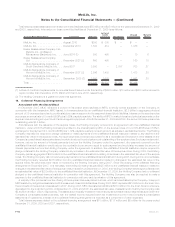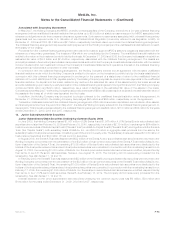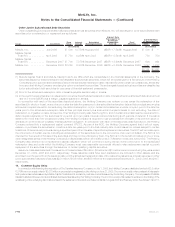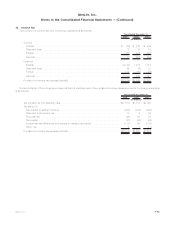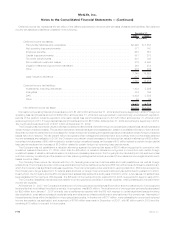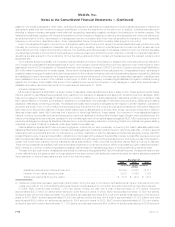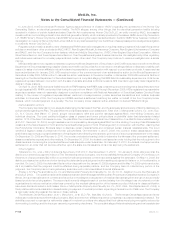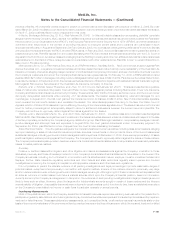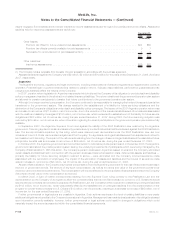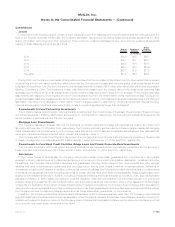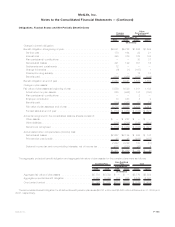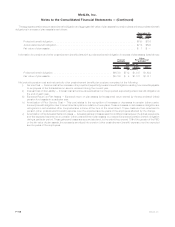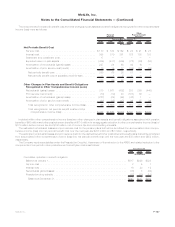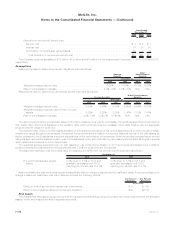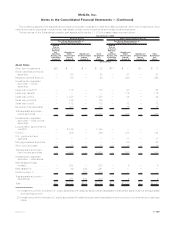MetLife 2009 Annual Report Download - page 183
Download and view the complete annual report
Please find page 183 of the 2009 MetLife annual report below. You can navigate through the pages in the report by either clicking on the pages listed below, or by using the keyword search tool below to find specific information within the annual report.years. The number of asbestos cases that may be brought, the aggregate amount of any liability that MLIC may incur, and the total amount
paid in settlements in any given year are uncertain and may vary significantly from year to year.
The ability of MLIC to estimate its ultimate asbestos exposure is subject to considerable uncertainty, and the conditions impacting its
liability can be dynamic and subject to change. The availability of reliable data is limited and it is difficult to predict with any certainty the
numerous variables that can affect liability estimates, including the number of future claims, the cost to resolve claims, the disease mix and
severity of disease in pending and future claims, the impact of the number of new claims filed in a particular jurisdiction and variations in the
law in the jurisdictions in which claims are filed, the possible impact of tort reform efforts, the willingness of courts to allow plaintiffs to pursue
claims against MLIC when exposure to asbestos took place after the dangers of asbestos exposure were well known, and the impact of any
possible future adverse verdicts and their amounts.
The ability to make estimates regarding ultimate asbestos exposure declines significantly as the estimates relate to years further in the
future. In the Company’s judgment, there is a future point after which losses cease to be probable and reasonably estimable. It is reasonably
possible that the Company’s total exposure to asbestos claims may be materially greater than the asbestos liability currently accrued and that
future charges to income may be necessary. While the potential future charges could be material in the particular quarterly or annual periods in
which they are recorded, based on information currently known by management, management does not believe any such charges are likely to
have a material adverse effect on the Company’s financial position.
During 1998, MLIC paid $878 million in premiums for excess insurance policies for asbestos-related claims. The excess insurance
policies for asbestos-related claims provided for recovery of losses up to $1.5 billion in excess of a $400 million self-insured retention. The
Company’s initial option to commute the excess insurance policies for asbestos-related claims would have arisen at the end of 2008. On
September 29, 2008, MLIC entered into agreements commuting the excess insurance policies at September 30, 2008. As a result of the
commutation of the policies, MLIC received cash and securities totaling $632 million. Of this total, MLIC received $115 million in fixed maturity
securities on September 26, 2008, $200 million in cash on October 29, 2008, and $317 million in cash on January 29, 2009. MLIC
recognized a loss on commutation of the policies in the amount of $35.3 million during 2008.
In the years prior to commutation, the excess insurance policies for asbestos-related claims were subject to annual and per claim
sublimits. Amounts exceeding the sublimits during 2007, 2006 and 2005 were approximately $16 million, $8 million and $0, respectively.
Amounts were recoverable under the policies annually with respect to claims paid during the prior calendar year. Each asbestos-related
policy contained an experience fund and a reference fund that provided for payments to MLIC at the commutation date if the reference fund
was greater than zero at commutation or pro rata reductions from time to time in the loss reimbursements to MLIC if the cumulative return on
the reference fund was less than the return specified in the experience fund. The return in the reference fund was tied to performance of the
S&P 500 Index and the Lehman Brothers Aggregate Bond Index. A claim with respect to the prior year was made under the excess insurance
policies in each year from 2003 through 2008 for the amounts paid with respect to asbestos litigation in excess of the retention. The foregone
loss reimbursements were approximately $62.2 million with respect to claims for the period of 2002 through 2007. Because the policies were
commuted at September 30, 2008, there will be no claims under the policies or forgone loss reimbursements with respect to payments made
in 2008 and thereafter.
The Company believes adequate provision has been made in its consolidated financial statements for all probable and reasonably
estimable losses for asbestos-related claims. MLIC’s recorded asbestos liability is based on its estimation of the following elements, as
informed by the facts presently known to it, its understanding of current law and its past experiences: (i) the probable and reasonably
estimable liability for asbestos claims already asserted against MLIC, including claims settled but not yet paid; (ii) the probable and reasonably
estimable liability for asbestos claims not yet asserted against MLIC, but which MLIC believes are reasonably probable of assertion; and
(iii) the legal defense costs associated with the foregoing claims. Significant assumptions underlying MLIC’s analysis of the adequacy of its
recorded liability with respect to asbestos litigation include: (i) the number of future claims; (ii) the cost to resolve claims; and (iii) the cost to
defend claims.
MLIC reevaluates on a quarterly and annual basis its exposure from asbestos litigation, including studying its claims experience, reviewing
external literature regarding asbestos claims experience in the United States, assessing relevant trends impacting asbestos liability and
considering numerous variables that can affect its asbestos liability exposure on an overall or per claim basis. These variables include
bankruptcies of other companies involved in asbestos litigation, legislative and judicial developments, the number of pending claims involving
serious disease, the number of new claims filed against it and other defendants and the jurisdictions in which claims are pending. As
previously disclosed, in 2002 MLIC increased its recorded liability for asbestos-related claims by $402 million from approximately $820 million
to $1,225 million. Based upon its regular reevaluation of its exposure from asbestos litigation, MLIC has updated its liability analysis for
asbestos-related claims through December 31, 2009.
Regulatory Matters
The Company receives and responds to subpoenas or other inquiries from state regulators, including state insurance commissioners;
state attorneys general or other state governmental authorities; federal regulators, including the SEC; federal governmental authorities,
including congressional committees; and the Financial Industry Regulatory Authority (“FINRA”) seeking a broad range of information. The
issues involved in information requests and regulatory matters vary widely. Certain regulators have requested information and documents
regarding contingent commission payments to brokers, the Company’s awareness of any “sham” bids for business, bids and quotes that the
Company submitted to potential customers, incentive agreements entered into with brokers, or compensation paid to intermediaries. The
Company has received a subpoena from and has had discussions with the Office of the U.S. Attorney for the Southern District of California
regarding the insurance broker Universal Life Resources. The Florida insurance regulator has initiated discussions with the Company
regarding its investigation of contingent payments made to brokers. The Massachusetts Office of the Attorney General has been conducting
a civil investigation of the rating practices of motorcycle insurers in Massachusetts including Metropolitan Property and Casualty Insurance
Company (“MPC”). MPC has reached an agreement with the Massachusetts Office of the Attorney General to resolve this matter by refunding
premiums with interest to affected policyholders. The Company has been cooperating fully in these inquiries.
F-99MetLife, Inc.
MetLife, Inc.
Notes to the Consolidated Financial Statements — (Continued)


